 Today is a fitting day to pray for the Holy Father, Pope Benedict. Saint Catherine was a woman of great courage and vision who promoted unity with the Church. Her crusade was a crusade for souls, for the salvation of many to heart of Christ through the ministry of Christ's vicar, the Pope. That today we are still in the Easter Octave, Siena's feast is not being observed except in places of the Order of Preachers. We are doing so today the Church of Saint Catherine of Siena, NYC, with a Octave Mass of Easter with elements of Saint Catherine's Mass parts intelligently placed; Holy Mass is being celebrated by the Most Rev'd Octavio Cisneros, an auxiliary bishop of Brooklyn.
Today is a fitting day to pray for the Holy Father, Pope Benedict. Saint Catherine was a woman of great courage and vision who promoted unity with the Church. Her crusade was a crusade for souls, for the salvation of many to heart of Christ through the ministry of Christ's vicar, the Pope. That today we are still in the Easter Octave, Siena's feast is not being observed except in places of the Order of Preachers. We are doing so today the Church of Saint Catherine of Siena, NYC, with a Octave Mass of Easter with elements of Saint Catherine's Mass parts intelligently placed; Holy Mass is being celebrated by the Most Rev'd Octavio Cisneros, an auxiliary bishop of Brooklyn.Saints: April 2011 Archives
 Today is a fitting day to pray for the Holy Father, Pope Benedict. Saint Catherine was a woman of great courage and vision who promoted unity with the Church. Her crusade was a crusade for souls, for the salvation of many to heart of Christ through the ministry of Christ's vicar, the Pope. That today we are still in the Easter Octave, Siena's feast is not being observed except in places of the Order of Preachers. We are doing so today the Church of Saint Catherine of Siena, NYC, with a Octave Mass of Easter with elements of Saint Catherine's Mass parts intelligently placed; Holy Mass is being celebrated by the Most Rev'd Octavio Cisneros, an auxiliary bishop of Brooklyn.
Today is a fitting day to pray for the Holy Father, Pope Benedict. Saint Catherine was a woman of great courage and vision who promoted unity with the Church. Her crusade was a crusade for souls, for the salvation of many to heart of Christ through the ministry of Christ's vicar, the Pope. That today we are still in the Easter Octave, Siena's feast is not being observed except in places of the Order of Preachers. We are doing so today the Church of Saint Catherine of Siena, NYC, with a Octave Mass of Easter with elements of Saint Catherine's Mass parts intelligently placed; Holy Mass is being celebrated by the Most Rev'd Octavio Cisneros, an auxiliary bishop of Brooklyn.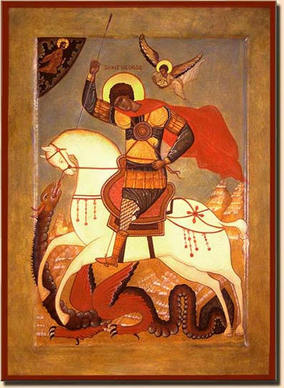
How can anyone not like Saint George's story? Whatever happened to the real cult of Saint George? Does the saint have contemporary relevance for us today? What witness does he offer the "post-modern" people we purport to be? Do we still struggle against Satan, the evil one, the great tempter? How do deal with the noontime devil that seeks to divide us from a filial relationship with God? Jesuit Father George Nedungatt, professor emeritus of the Pontifical Oriental Institute (Rome) wrote an essay "Saint George without the Dragon" explaining contemporary --at least since Vatican II-- Church's remembrance of and prayerful reliance on, the Lord's dragon slayer. As the summary of the article says, "The post-conciliar reform has entered the liturgical celebration of St. George [on April 23] amidst the facultative memoirs, attributing the historical date of his martyrdom in Lydda circa 303. It follows the protest, both by those who have chosen St. George as patron and, and for opposing reasons, by those who deny the killing of the dragon by the saint. To shed light on the issue, the article distinguishes between the current liturgical (the cult certificated since ancient time on the saint's tomb), and the literary tendency, (legends based on his figure as a symbol of the struggle against the forces of evil)." You can read about Saint George in La Civiltà Cattolica (3859, 2011, II, pp. 20-29).
Subtle differences need certain light in a canonization process. Scholasticism advocates that we always distinguish. Benedict XVI will be beatifying his friend, colleague and boss, Pope John Paul II on May 1. So, the faithful are asking what's the difference between the ecclesial acts of beatification and canonization?
The Holy See told us what's considered to be the distinguishing marks of any beatification. There are three differences:
- location of dioceses that can hold annual public liturgical celebrations in the holy person's honor;
- who ceremonially requests the pope to act;
- and the level of papal authority involved in the proclamation.
What Pope Benedict has worked hard to remind the Church, "at a beatification ceremony, the bishop of the diocese where the person dies asks that the candidate be declared blessed; at a canonization, the prefect of the Congregation for Saints' Causes speaks in the name of the whole church and asks that the candidate be declared a saint."
But a central
difference between a beatification and canonization is that with a canonization
there is an act of declaring dogmatically, that God has revealed this person
with Him in beatitude. Essentially, it is a matter of papal infallibility.
Being a saint is a dogmatic statement; being a blessed is not. A saint can be
liturgically commemorated at the sacred Liturgy worldwide and remembered in
other circumstances like naming buildings after the person. When the Church
says a person is a blessed, it is an administrative act of the papal office; a
blessed can be liturgically commemorated is limited to certain circumstances,
like where the person lives or in the houses of the religious congregation
should the person be a religious.
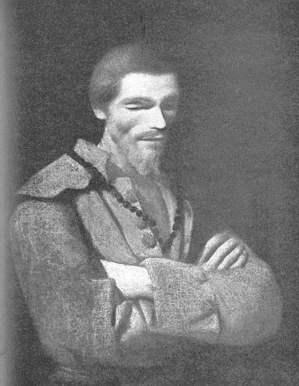 Blessed are the poor in spirit for theirs is the Kingdom of Heaven; Blessed are the pure in heart for they shall see God. (MT 5:3,8)
Blessed are the poor in spirit for theirs is the Kingdom of Heaven; Blessed are the pure in heart for they shall see God. (MT 5:3,8)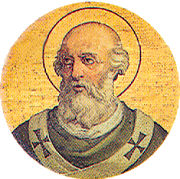 Merciful God, our Father, neither hardship, pain,nor the threat of death could weaken the faith of Saint Martin. Through our faith, give us courage to endure whatever sufferings the world may inflict upon us.
Merciful God, our Father, neither hardship, pain,nor the threat of death could weaken the faith of Saint Martin. Through our faith, give us courage to endure whatever sufferings the world may inflict upon us.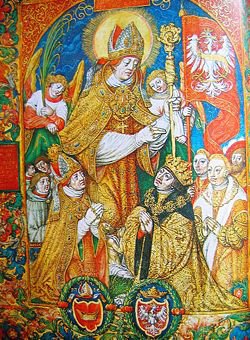 As a child my sister, cousin and I were enrolled in St Stanislaus School (New Haven, CT) under the guidance of the Vincentians and the Sisters of the Holy Family of Nazareth. The great bishop and martyr has been in my consciousness for some time and it was a privilege to make deeper connections with the saint when I was in Krakow a number of years ago. We Poles regard the sainted bishop and martyr Stanislaus as Poland's Saints Thomas Becket and Thomas More who took a stand against societal and governmental injustice. Today, we'd use the term "speak truth to power" to capture what Stanislaus did in his native Poland.
As a child my sister, cousin and I were enrolled in St Stanislaus School (New Haven, CT) under the guidance of the Vincentians and the Sisters of the Holy Family of Nazareth. The great bishop and martyr has been in my consciousness for some time and it was a privilege to make deeper connections with the saint when I was in Krakow a number of years ago. We Poles regard the sainted bishop and martyr Stanislaus as Poland's Saints Thomas Becket and Thomas More who took a stand against societal and governmental injustice. Today, we'd use the term "speak truth to power" to capture what Stanislaus did in his native Poland.Frère André, nous t'acclamons: Dieu t'achoisi depuis toujours. Grand ami de Saint Joseph, prie pour nous dans la gloire. (hymn by M. Dubé, OP).
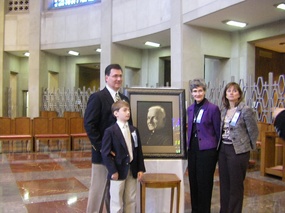
Today the members of the Congregation of Holy Cross gathered for a Mass of Thanksgiving for the Canonization of Saint André Bessette of Montréal at the Cathedral of Saint Joseph, celebrated by His Excellency, the Most Reverend Henry J. Mansell, archbishop of Hartford. About 250 people attended the Mass, including members of André Alfred Bessette's family, a few alumni of the Notre Dame High School (West Haven, CT) and Holy Cross High School (Waterbury, CT). Several of the Brothers and Fathers of Holy Cross came from a good distance with together for this wonderful occasion. It's not everyday that one could say that a saint has come from your region of the world! Saint André, as very young man, labored outside of his native Canada in New Hampshire and Connecticut.

